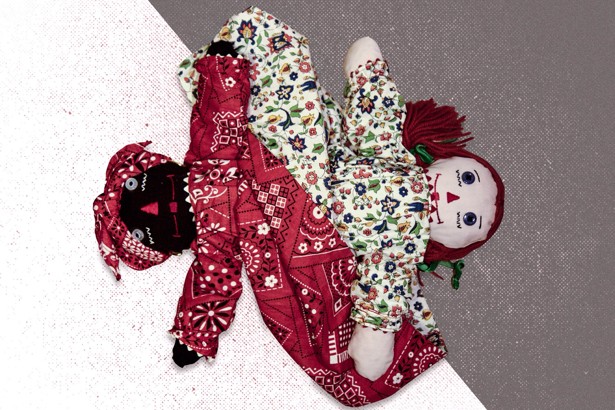
The doll is two-headed and two-bodied—one black body and one white, conjoined at the lower waist where the hips and legs would ordinarily be. The lining of one's dress is the outside of the other’s, so that the skirt flips over to conceal one body when the other is upright. Two dolls in one, yet only one can be played with at a time.
The topsy-turvy doll, as it’s known, most likely originated in American plantation nurseries of the early 19th century. By the mid-20th century, they’d grown so popular that they were mass-manufactured and widely available in department stores across the country, but today, they’re found mostly in museums, privatecollections, and contemporaryart. In recent years, the dolls have seen a renewed interest from collectors and scholars alike, largely motivated by the ongoing question that surrounds their use: What were they supposed to symbolize?
It’s unclear whether topsy-turvy dolls were first created to reinforce racial and sexual power dynamics or if they were something more subversive. Either way, the dolls have since the beginning been reinterpreted and appropriated to suit the use of their makers, the children who played with them, and the people who felt they were worth preserving—their purpose was always context-dependent, a moving mirror of racial womanhood.
The dolls, like most toys, were much more than neutral props for make-believe; they were instructional, too. As the game designer and “fun theorist” Bernie DeKoven wrote in his book Interplay, “Every game that a child plays is somehow connected with learning about people.” This process can be incidental or deliberate, but it’s usually a bit of both. A child’s sense of fairness, and of his or her place in society, is often shaped by the playtime lessons of who makes the rules and who follows them.
The ways that children played with their topsy-turvy dolls, therefore, likely mirrored the power dynamics within their own households. In some cases, they were likely used by the young slave children and the children of their owners. In her book Women in Early America, the historian Dorothy A. Mays explains that slave girls on plantations were often paired with the similarly aged daughters of their owners “to be companion and servant.” In these situations, perhaps playing together with such explicitly racial toys helped children to internalize the social divisions between them, or perhaps it was a chance to forget them.
Or perhaps it was a reminder, however subtle, of the plight of their caregivers. For 19th-century white women of means, the expectation to have children as a fulfillment of womanhood conflicted with class expectations to outsource physical work. In practice, this meant that the demands of childcare often fell to slaves or servants. In her book Mammy: A Century of Race, Gender, and Southern Memory, Kimberly Wallace-Sanders makes the case that the first dolls were made by black wet nurses as a reflection of “the division of caregiving that African American women encountered, having to care for white children during the day and their own children at night.” The two-sided toys were “important, creative expressions,” she concludes, “of those otherwise silent women.” (Some collectors have also theorized that the women originally made the dolls for their own children, who wanted to imitate their mothers by caring for white babies, though historical evidence for this idea is scant.)
The dolls may have also been a sly way for their creators to comment more broadly on ideas about race. Topsy-turvy dolls were born into an economy dependent on the idea of inherent racial differences, and a country full of white scholars invested in perpetuating this myth. “The figure of the white Negro,” Charles D. Martin writes in his book The White African American Body, “consistently inspired fears of a world turned topsy-turvy. Black can fade to white; white can blacken.” Amid these fears of white and black bodies mingling, the dolls were a symbol of the ways in which they did just that—through wet nursing, but also through the biracial children born from slaveowners raping their female slaves.
The legacy of topsy-turvy dolls continued long after abolition. In the 1920s, the Vaudeville performers Rosetta and Vivian Duncan capitalized on their extremely popular “Topsy and Eva” blackface comedy routines—named for the characters in Harriet Beecher Stowe’s Uncle Tom’s Cabin—with a 1927 silent film of the same title. Soon after, “Topsy and Eva” became a common alternative name for the topsy-turvy doll, solidifying its link to the blackface-slapstick brand of entertainment.
But topsy-turvy dolls shouldn’t be seen as toys that make simplistic, definitive claims about race. Their origin was at times subversive, playful, and a means of expressing the complexities of race relations during and after slavery. In 2011, the artist Cori Spencer advertised a performance of her work Little Black Topsy and the Magical White Fairy Soap with an image of a topsy-turvy doll. Spencer chose the image, she explained, as a symbol of her own experiences as a young black woman: “These sorts of conflicted fantasies about transgression, and repulsion, and desire are written into the very fabric of [society],” she said. Long past their prime as playthings, topsy-turvy dolls continue to ignite discussion in large part because they resist being squarely fixed to one meaning—instead, they flip back and forth between ideas that conflict even as they coexist.